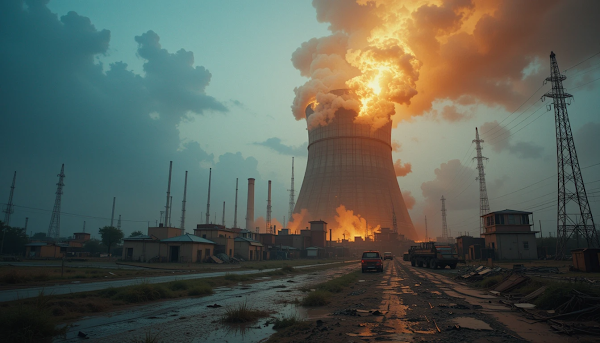In recent days, an unsettling narrative has gripped public attention in South Asia: rumors of a nuclear radiation leak at Pakistan’s Kirana Hills. These allegations gained traction following reports of an Indian military operation—Operation Sindoor—and speculated strikes on strategic locations in Pakistan. Social media platforms lit up with claims of a potential disaster, prompting alarm and anxiety among citizens and analysts alike.
However, as the dust begins to settle, it has become evident that the story is more about misinformation than verified facts. Official sources, including the International Atomic Energy Agency (IAEA), the Indian Air Force (IAF), and the Pakistan Nuclear Regulatory Authority (PNRA), have categorically denied any such incident. In this article, we delve into the background of the Kirana Hills, analyze the alleged leak and its supposed causes, and explore the political and strategic dimensions fueling the rumors.
Background: The Strategic Importance of Kirana Hills
The Kirana Hills, located in Pakistan’s Sargodha district in Punjab, are of significant strategic importance. The region is known for its proximity to Pakistan’s military installations and has long been speculated as a site for nuclear-related activities, including storage and possibly testing in the early stages of Pakistan’s nuclear weapons development program during the 1980s.
Though never officially confirmed, the area has frequently appeared in defense analyses and strategic assessments. Due to its classification as a high-security zone, even minor incidents in or around Kirana Hills often become the subject of intense scrutiny and speculation.
The Emergence of the Rumor
The recent rumors of a radiation leak surfaced shortly after reports emerged of a covert Indian military operation, dubbed “Operation Sindoor.” While details of the operation remain sparse, speculative claims suggested that Indian fighter jets conducted precision airstrikes deep inside Pakistani territory, allegedly targeting nuclear infrastructure, including the Kirana Hills.
The narrative quickly escalated on social media platforms, where users began sharing unverified videos, satellite images, and anecdotal accounts of unusual military and civilian activity in the area. Hashtags related to “Kirana Hills,” “radiation leak,” and “Operation Sindoor” began trending in Pakistan and India. Some posts even alleged that local populations were being evacuated and that foreign surveillance aircraft had been spotted over the region.
Official Denials: Cutting Through the Noise
IAEA’s Statement
The most authoritative rebuttal to the radiation leak claims came from the International Atomic Energy Agency (IAEA), the global nuclear watchdog. In a clear and decisive statement, the IAEA affirmed:
“There has been no radiation leak or release from any nuclear facility in Pakistan.”
This statement was aimed at quelling growing international concerns and highlighted the IAEA’s ongoing monitoring of nuclear activities through its global network.
Indian Air Force Clarifies Position
Adding to the denials, Air Marshal A. K. Bharti, Director General of Air Operations for the Indian Air Force, denied any involvement in airstrikes on the Kirana Hills. When questioned during a press briefing, he stated:
“We have not hit Kirana Hills—whatever is there. These are speculative stories.”
His denial further cast doubt on the credibility of the reports circulating in Indian and Pakistani media outlets.
Pakistan Nuclear Regulatory Authority (PNRA)
The PNRA also released a statement confirming that no abnormal radiation levels had been recorded at any of Pakistan’s nuclear facilities. The agency emphasized its robust monitoring and safety protocols, asserting that all facilities were operating within standard safety margins.
Understanding the Public Reaction
While the official denials were swift and clear, the public reaction told a different story. In regions close to the alleged site of the leak, there were reports of panic buying, hospital overcrowding, and heightened security presence—interpreted by some as evidence that something was amiss.
However, experts argue that such reactions are typical in environments with high mistrust in institutions and low transparency. The mere possibility of a radiation leak, even if entirely baseless, is enough to trigger mass fear and speculation.
Moreover, the timing of the rumors—amid heightened India-Pakistan tensions—amplified their impact. In such a climate, misinformation can spread rapidly, feeding into long-standing geopolitical anxieties and fueling a cycle of mutual suspicion.
Geopolitical Ramifications
Allegations of a nuclear mishap, even if false, have far-reaching implications for regional stability. In South Asia, where India and Pakistan have fought several wars and maintain active nuclear arsenals, any narrative involving nuclear facilities can quickly escalate into a diplomatic crisis.
Had the rumors been taken at face value by either side, they could have provoked retaliatory measures, military mobilization, or at the very least, diplomatic fallout. Fortunately, the swiftness of the official responses appears to have contained the situation before it could spiral further.
That said, the incident underscores the need for better communication channels between the two nations, particularly in the realm of nuclear safety and crisis management. Confidence-building measures (CBMs), such as real-time alerts and mutual verification protocols, could help prevent misunderstandings in the future.
The Role of Disinformation and Social Media
This episode also serves as a case study in the power—and danger—of disinformation. The speed at which unverified claims spread through platforms like X (formerly Twitter), Facebook, and WhatsApp highlights a growing vulnerability in the information landscape.
While social media can democratize information, it also provides fertile ground for the spread of sensational and false narratives. In this case, manipulated images, AI-generated videos, and anonymous testimonies played a central role in building the illusion of a crisis that never occurred.
Governments and media organizations must invest in digital literacy and verification tools to help citizens distinguish between reliable information and propaganda. Failure to do so could lead to real-world consequences, including mass panic, diplomatic incidents, and erosion of public trust.
Historical Context: Nuclear Safety in Pakistan
It’s worth noting that Pakistan has a reasonably solid track record when it comes to nuclear safety. Despite being a relatively young nuclear state, Pakistan has cooperated with international watchdogs, including the IAEA, and has developed stringent internal protocols for the management of nuclear materials.
The country has also established a Nuclear Command Authority (NCA) and Strategic Plans Division (SPD) to oversee the operational safety and strategic deployment of its nuclear assets. Regular audits and inspections are conducted to ensure the integrity of facilities and the safety of personnel.
While no country is immune to accidents, Pakistan’s nuclear infrastructure is generally considered secure by independent experts. There has never been a confirmed case of a nuclear leak or accident involving civilian casualties.
What Should Citizens Do During Such Rumors?
In the wake of such incidents, it is essential for the public to adopt a critical approach to information. Here are some tips to navigate similar situations:
- Rely on Verified Sources: Always check for updates from official agencies such as the IAEA, PNRA, or government ministries.
- Avoid Forwarding Unverified Content: Sharing unverified videos or images can contribute to panic.
- Check Multiple Sources: Look for corroboration from international news outlets and independent watchdogs.
- Understand Emergency Protocols: Familiarize yourself with local emergency procedures for nuclear or chemical incidents, even if the probability of such events is low.
Conclusion
The alleged nuclear radiation leak at Pakistan’s Kirana Hills turned out to be a fabrication, but the incident offers valuable lessons. It highlights the volatile intersection of geopolitics, public perception, and the digital information ecosystem. In an age where misinformation can spark real-world crises, the responsibility falls on governments, media, and individuals alike to ensure that truth is not the first casualty of rumor.
As the region continues to grapple with complex security challenges, trust, transparency, and technology must be leveraged to prevent future flare-ups driven by fiction rather than fact. For now, the nuclear facilities of Pakistan remain secure—and the real threat lies not in radiation, but in rumors.











